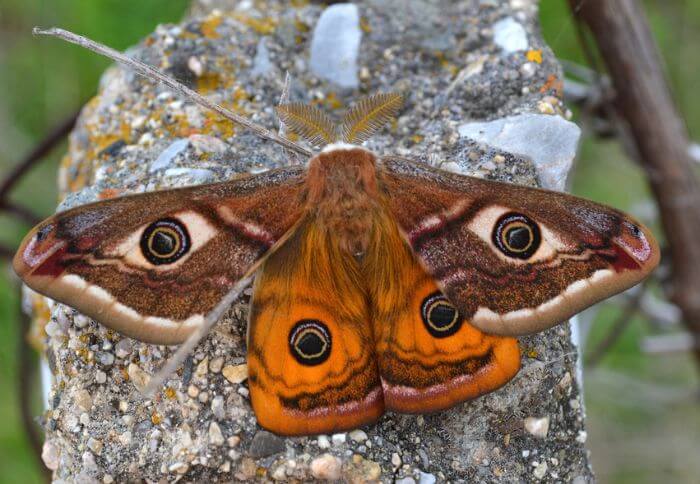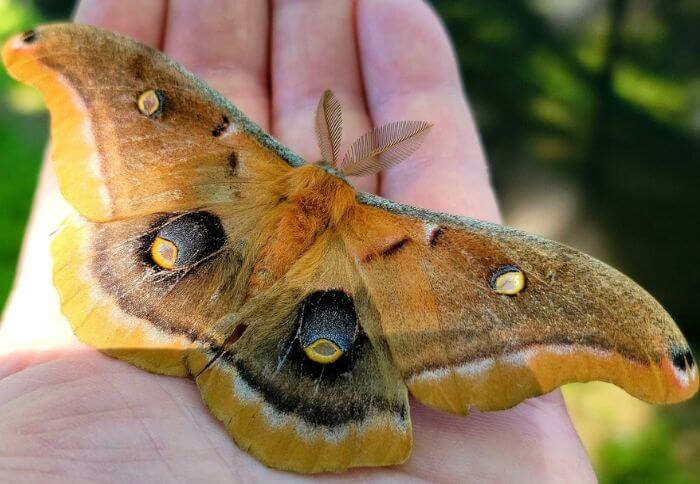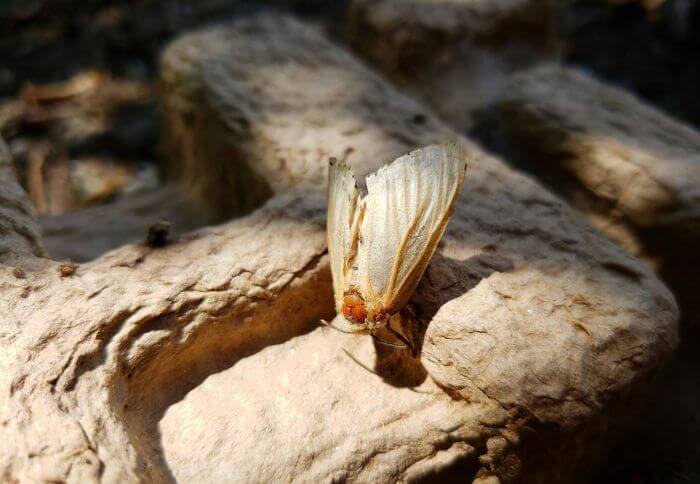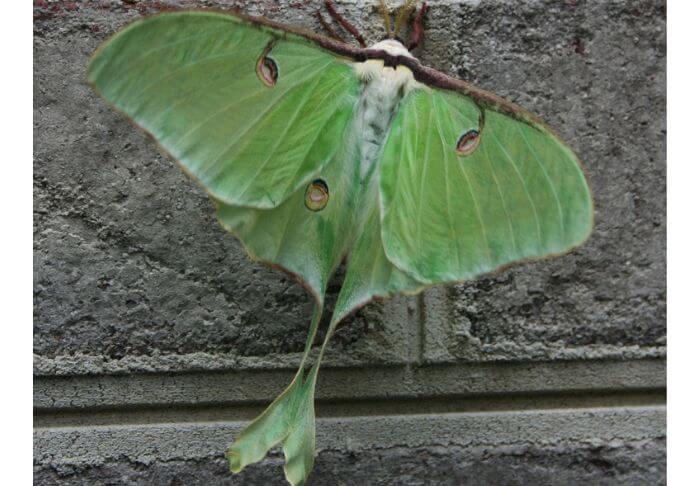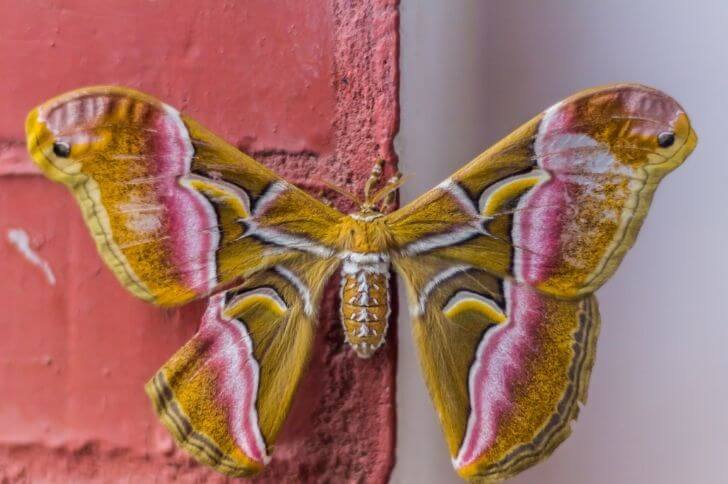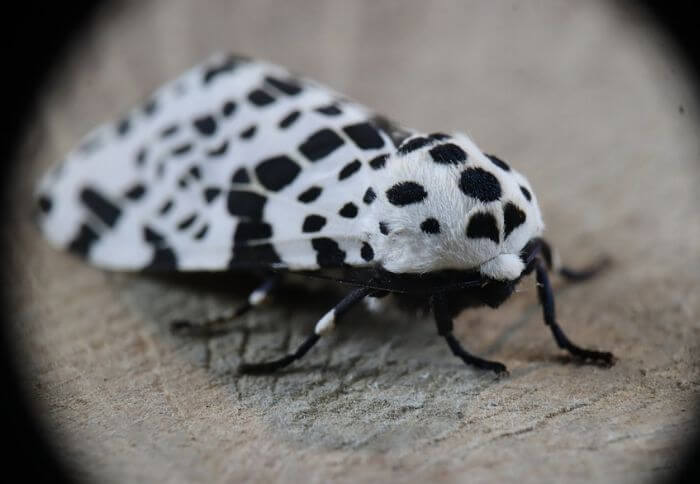Orange Caterpillar with Spikes (11 Species)
Are you curious about the diverse and fascinating world of caterpillars? Prepare to be amazed as we delve into a particular subset of these wiggly creatures: orange caterpillars with spikes.
From their vibrant coloration to their intimidating appearances, these spiky critters are sure to captivate your imagination. Join us on this enthralling journey as we explore the different types of orange spiky caterpillars and uncover their intriguing characteristics.
Orange Caterpillar with Spikes
1. Oleander caterpillar
Hidden among the vibrant leaves of the Oleander plant, a fascinating creature lurks: the Oleander caterpillar. With its striking appearance, featuring bold orange coloration and rows of menacing black spikes along its elongated body, this creature commands attention.
But do not be fooled by its alluring beauty – the Oleander caterpillar packs a venomous punch that serves as a defense mechanism against predators.
Feeding exclusively on the foliage of Oleander plants, these voracious caterpillars are specialized herbivores. Their bright orange hue acts as a warning to would-be attackers, signaling their unpalatability due to their toxic diet.
Despite their powerful defense mechanisms, the lifecycle of an Oleander caterpillar is short-lived; once they pupate in small yellow cocoons hidden in soil or debris near their host plant, they emerge as delicate and stunning butterflies.
Oleander caterpillars occupy a unique niche within ecosystems dominated by Oleander plants. As specialists that feed solely on this particular vegetation, they play an essential role in controlling plant growth and keeping it in balance with other species.
While they may appear intimidating with their spikes and venomous nature, these beautiful creatures contribute to maintaining biodiversity within their respective habitats.
2. Gulf Fritillary Caterpillar
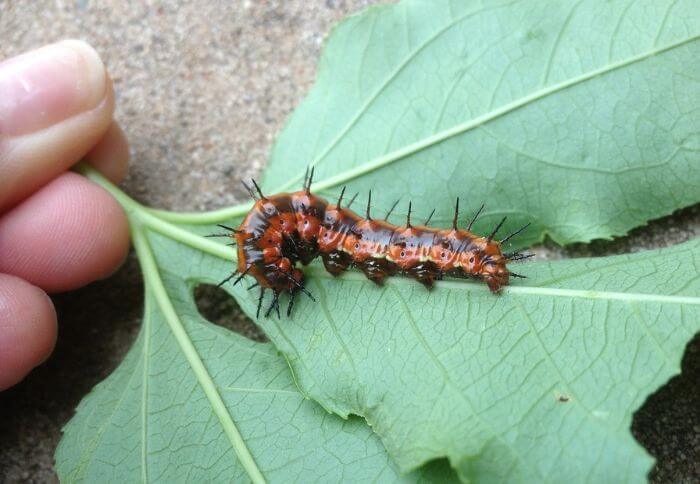
The Gulf Fritillary Caterpillar is a fascinating creature, known for its vibrant color and unique appearance.
These orange caterpillars, adorned with striking black spikes along their bodies, are commonly found in the southern parts of the United States. Their bold colors serve as a warning sign to predators that they are not to be messed with.
It is interesting to note that these caterpillars undergo multiple molts before transforming into butterflies. Each molt reveals a new color pattern on their bodies, making them even more eye-catching as they grow.
Additionally, these spikes aren’t just for show – they actually serve a defensive purpose by deterring potential threats and offering protection against predators.
While many caterpillars may appear similar in nature, the Gulf Fritillary Caterpillar stands out due to its distinct and captivating attributes. It serves as a reminder of the incredible diversity we can find even within this seemingly simple insect world.
3. Salt Marsh Caterpillar
The salt marsh caterpillar, or Estigmene acrea, is an intriguing creature with its vibrant orange hue and conspicuous spikes. Found in the coastal areas of North America, this caterpillar undergoes a transformation like no other.
As it feeds on various plants in marshy habitats, its coloration serves as a warning to potential predators that it is not to be messed with. The bright orange acts as a visual deterrent, advertising the presence of toxins within its body that can cause irritation and even harm.
Don’t be fooled by their vibrant appearance though; these caterpillars have more tricks up their sleeves (or should I say spikes?).
Their spiky hairs may look menacing, but they actually serve two purposes. Firstly, the spikiness provides additional protection against predators like birds or small mammals trying to make a quick meal out of them. Secondly, these hairs act as sensors for detecting subtle changes in their environment such as temperature and humidity.
Interestingly enough, while most caterpillars deploy camouflage techniques to blend into their surroundings, the salt marsh caterpillar stands out boldly with its fiery orange coloration and spikes.
Perhaps this is nature’s way of saying don’t mess with me! It serves as a reminder that sometimes being different and standing out from the crowd can have its own advantages when it comes to survival in the wild.
4. Baltimore Checkerspot Caterpillar
The Baltimore Checkerspot Caterpillar may be small in size, but it is certainly hard to miss with its vibrant orange body adorned with rows of black spikes.
These distinctive markings serve as a warning to potential predators that this caterpillar is not to be trifled with. But there’s more to these orange critters than meets the eye.
These caterpillars have an intriguing life cycle that begins when they emerge from their eggs and start feeding on their exclusive host plant, the white turtlehead.
As they grow, they shed their outer skin multiple times, revealing larger and more colorful versions of themselves each time. It’s amazing how nature has equipped this tiny creature with such intricate patterns and hues.
What’s even more fascinating is the role these caterpillars play in the ecosystem. They are not only vital pollinators but also a crucial part of the food chain for various predators like birds and reptiles.
Their striking appearance serves as protection against would-be attackers who quickly learn to watch out for those orange spikes.
5. Red-humped Moth Caterpillar
The red-humped moth caterpillar, with its vibrant orange color and distinctive spikes, is a fascinating creature that captivates the attention of all who come across it.
These little critters are not just visually striking but also possess some interesting survival adaptations. The spiky protrusions on their bodies not only serve as a deterrent for potential predators but also provide them with camouflage among thorny plants and foliage.
Despite its impressive appearance, the red-humped moth caterpillar’s life cycle is relatively short-lived. After hatching from eggs laid by adult moths, they quickly grow and molt several times before entering their pupal stage.
During this transformative period, they undergo remarkable physiological changes within the safety of a cocoon. In no time at all, these orange caterpillars will emerge as beautiful moths ready to continue their species’ lifecycle.
These intriguing creatures have piqued the interest of scientists who study mimicry in nature. It is believed that the bright orange coloration and spiky exterior of the red-humped moth caterpillar may be imitations inspired by toxic or unpalatable species.
By mimicking dangerous organisms, these caterpillars can deter potential predators seeking an easy meal, showcasing yet another stunning example of nature’s ingenuity.
6. Variegated Fritillary Caterpillar
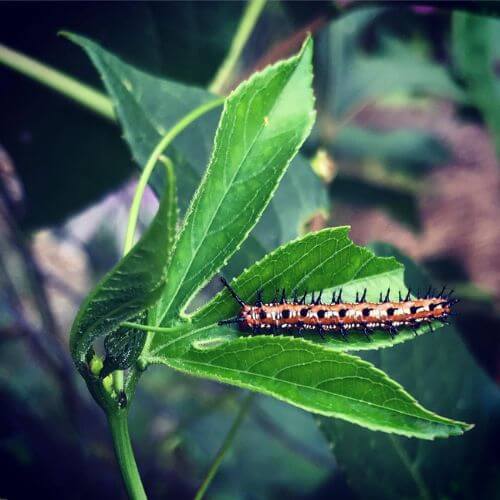
source: hootowlkarma
The Variegated Fritillary Caterpillar, with its vibrant orange color and distinct spikes, is a fascinating creature to behold. Behind its striking appearance lies a hidden strategy for survival.
These caterpillars are often found feeding on passion flower plants, which are known to produce toxic chemicals as a defense mechanism against herbivores.
However, the Variegated Fritillary Caterpillar has developed a unique adaptation that allows it to not only tolerate these toxins but also sequester them within its own body as a means of protection.
As these caterpillars grow and feed on passion flower leaves, they absorb the poisonous compounds from their host plant into their own tissues. This clever technique not only makes them unpalatable to would-be predators but also serves as a form of self-defense.
By storing these toxins in their bodies, the caterpillars advertise their distastefulness and warn potential threats of the consequences if consumed. It’s nature’s way of saying eat me at your own risk.
Related Read; check common spiky caterpillars
7. Spiny Oakworm Caterpillar
The spiny oakworm caterpillar is a fascinating creature that is often misunderstood due to its intimidating appearance. Covered in sharp, black spines and boasting vibrant orange coloration, this caterpillar can easily send shivers down the spine of anyone who encounters it.
However, beneath its formidable exterior lies a gentle and harmless caterpillar that plays a vital role in the ecosystem.
Despite their fearsome appearance, spiny oakworm caterpillars are not venomous and do not pose any threat to humans or pets. In fact, these little critters are quite beneficial as they help control the population of certain tree species by feeding on their leaves.
The spines on their bodies act as protection against predators and also give them a striking visual appearance, serving as a warning sign to potential threats.
During the cooler months, you may notice large groups of these caterpillars congregating on trees or making long journeys together in search of suitable places to pupate. While some might find this sight unsettling, it is actually a natural part of their lifecycle.
This behavior allows the caterpillars to protect themselves from predators by overpowering them with sheer numbers while they undergo their transformation into moths.
8. Yellow-tail Moth Caterpillar
When it comes to orange caterpillars with spikes, the yellow-tail moth caterpillar immediately stands out. With its vibrant orange coloration and trademark spiky hairs that cover its body, this caterpillar is unmistakable in appearance. But there is more to this creature than just its striking visuals.
Known scientifically as Euproctis spp., the yellow-tail moth caterpillar can be found in various regions around the world. Despite their attractive appearance, these larvae are not to be toyed with.
Those sharp spines may look harmless, but they actually serve a defensive purpose. When threatened, the yellow-tail moth caterpillar releases venomous toxins from these tiny spikes, delivering a painful sting to potential predators such as birds or mammals.
Apart from their potent defense mechanism, these caterpillars also possess an interesting feeding behavior. They primarily feed on deciduous trees like oak or birch leaves but have been known to occasionally munch on coniferous foliage as well.
This adaptability ensures they can survive in diverse environments and provides them with a steady food source throughout their development stages.
9. Unexpected Cycnia Moth Caterpillar
One of the most fascinating caterpillar species to come across is the Unexpected Cycnia Moth Caterpillar. With its vibrant orange color and intricate patterns, this little creature is sure to catch your eye.
But what sets it apart are the tiny spikes that adorn its body, making it look like a miniature punk rocker in the insect world.
The unexpected part about these caterpillars is their protective strategy. The spikes might seem intimidating at first glance, but they actually serve as a defense mechanism against predators.
When threatened, the caterpillar contracts its body, causing the spikes to protrude even more. This not only makes it difficult for predators to swallow them but also acts as a deterrent by inflicting pain upon contact.
Observing these caterpillars up close can provide us with a valuable lesson in adaptation and survival techniques in nature. It’s amazing how something so small and seemingly delicate can possess such an effective defense system against larger threats.
Nature continues to surprise us with its incredible diversity and resilience—teaching us important lessons along the way.
10. Imperial Moth Caterpillar
The Imperial Moth caterpillar is a striking creature that captures the imagination with its vibrant orange color and large size. But what truly sets this caterpillar apart are its fascinating spikes, which adorn its body and serve as a defense mechanism.
These sharp spines not only act as a deterrent to potential predators but also add an element of intimidation.
One would think that such outward displays of protection would discourage any potential threats, but recent studies have shown that there is more to these spikes than meets the eye.
Researchers have discovered that the spines not only provide physical protection but also release a chemical substance when touched, further deterring attackers.
This extraordinary adaptation serves as a testament to nature’s ability to evolve and protect its inhabitants in unexpected ways.
Aside from their incredible defense system, these orange caterpillars with spikes undergo several transformations before emerging as beautiful adults. They start off small and inconspicuous before growing into full-fledged orange powerhouses with awe-inspiring spikes.
It is remarkable how these once unassuming creatures transform themselves physically and learn to defend against any danger they may encounter in their environment.
11. Buck Moth Caterpillar
The Buck Moth Caterpillar, with its striking orange hue and menacing spikes, is one of nature’s most mesmerizing creatures.
Found primarily in the southern United States, this caterpillar may seem like something out of a Halloween nightmare with its ferocious appearance. But behind its fearsome exterior lies a fascinating life cycle and notable ecological role.
What sets the Buck Moth Caterpillar apart from other caterpillars is its unique defense mechanism. Those intimidating spikes are not just for show; they contain venom that can cause painful stings to anyone unlucky enough to touch them.
This adaptation serves as protection against potential predators, effectively warding off any would-be enemies before they even have a chance to attack. Furthermore, these spikes are more prominent on mature caterpillars than younger ones, suggesting that they play an increasingly important role as the caterpillar grows.
Despite their fierce appearance, these orange spiky caterpillars are actually quite beneficial to their ecosystems. As voracious eaters and herbivores, they mainly feed on oak trees, helping maintain balance within this crucial tree population by keeping it in check.
Moreover, the buck moth itself plays its part in pollination once it emerges from its cocoon as an adult moth. Thus, while their physical attributes may inspire fear or repulsion at first glance, these remarkable insects serve an essential purpose in nature’s intricate web of life.
12. Spiky Oakworm Caterpillar
The spiky oakworm caterpillar may not have the vibrant colors of its orange counterparts, but what it lacks in hue, it more than makes up for in intimidation. With long black spikes covering its body, this caterpillar means business.
And while its appearance may be intimidating to some, these spikes actually serve as a defense mechanism against potential predators. When threatened, the spiky oakworm caterpillar can use its sharp spikes to fend off attackers and protect itself.
But there’s more to this curious creature than meets the eye. The spiky oakworm caterpillar is not only masters of self-defense; they are also incredibly resourceful when it comes to finding food.
These caterpillars feed exclusively on oak leaves and have developed a unique strategy for ensuring their survival. By forming colonies and munching through leaves together, they create a communal protective layer that shields them from predators while providing an abundant food source.
This social eating behavior not only ensures their own survival but also strengthens interactions within their community.
13. Faithful Beauty Caterpillar
The Faithful Beauty caterpillar is nature’s artwork in motion. With its sleek orange body adorned with black spikes, it captures the eye and demands attention.
But beyond its striking appearance, this caterpillar has a fascinating life cycle that highlights the wonders of adaptation.
One remarkable aspect of the Faithful Beauty caterpillar is its ability to ward off predators. The spikes on its body serve as a deterrent, deterring potential threats from considering it as an easy meal.
These spikes act not only as a physical defense mechanism but also send powerful signals to predators that this is no ordinary prey.
Another captivating feature of this caterpillar is its transformation into a butterfly. After spending weeks feeding on leaves and growing rapidly, it spins itself into a cocoon, becoming completely immobile.
Inside this protective casing, incredible changes are taking place: cells are rearranging and differentiating, forming intricate wings that will eventually enable the creature to take flight.
Final thoughts
There are several types of orange caterpillars with spikes that can be found in various parts of the world. These unique creatures not only display stunning colors, but their spikes serve as a defense mechanism against predators.
From the striking oleander moth caterpillar to the fearsome Baltimore checkerspot caterpillar, each species has its own distinct characteristics and behaviors. Learning about these orange spiky caterpillars can be an exciting and educational experience for nature enthusiasts and curious observers alike.
source:
Passionate animal photographer with an unwavering love for capturing the essence and beauty of our furry friends.
With over five years of experience in the field, I have developed a unique ability to connect with animals on a deeper level, allowing me to create stunning and captivating images that truly reflect their personality.
Let’s collaborate to capture unforgettable moments that celebrate the unique bond between humans and animals!
